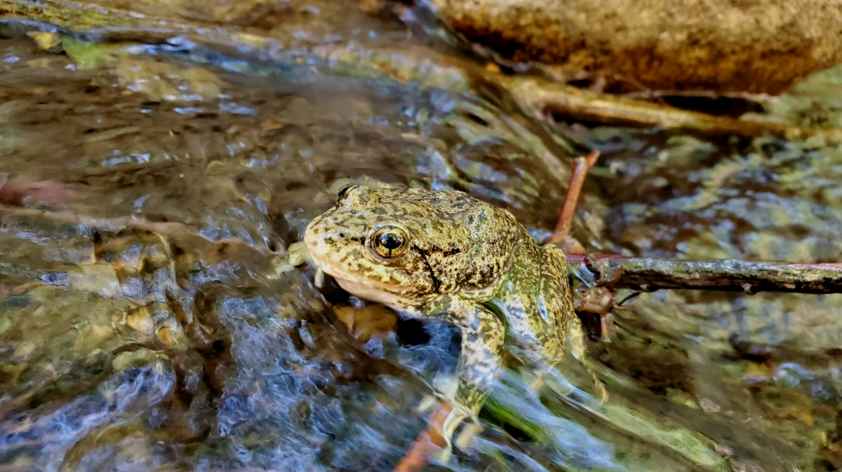
Where do they go? Using new technology to track the movements of frogs after they’re reintroduced.
One difficulty faced by any involved in conservation programs is the ability to detect and monitor individuals after their reintroduction into the wild. Fortunately, new technology arises to aid in the remote detection of individuals that can completely redefine animal translocations and reintroductions.
The mountain yellow-legged frog team recently deployed a stand-alone, microchip reader at one of our more promising sites of animal reintroduction.
Historically, up until last year, any surveys conducted after a reintroduction event were attempted by sight alone to try and monitor the survival and movement of reintroduced animals. As our animals are very cryptic and blend superbly into the rock walls and stream beds they are placed into, visual survey techniques were not very accurate nor effective.
Last year saw a significant increase in detection thanks to a long-range microchip reader that could identify the chips that all our released animals possess. Although very successful, using the long-range reader still required a human facilitator and thus surveys could only occur once a week to a few times a month. Because of this, and because of the success of the reader when used, the team decided to integrate a stand-alone reader that could track individual’s movements post-release without the necessity of having a human user on site.
The technology to accomplish this feat is relatively new and relatively untested in this type environment. Additionally, this technology is still in the first stages of optimization and requires bulky and at times complicated infrastructure.
For instance, to run the circuit board and electronics to keep the cord reading microchips the design calls for two very heavy, very unwieldy, car batteries. The car batteries themselves can keep the equipment up and running for about four days, which means, that the device also needs some sort of charger to replenish the batteries and keep the device running for long periods of time (months if needed).
Solar panels ended up being the most efficient way to keep the system charging and running while not attended. The circuit board itself is still a rather large construction and thus placed in a water-proof case measuring roughly 1m x 2m (3’ x 4’) in size. The device that reads the pit tags and transmits the information to the circuit board is a 15m (50’) cord that needs to be placed in a very specific configuration for optimal pit tag reading ability.
Needless to say, in order to cart all of this equipment, plus the necessary hardware for mounting and securing said equipment we needed a team of volunteers and colleagues. Total distance from our parked cars to the field site was roughly 500 m (1640 feet) of half unstable mountaineering and half slippery stream crawling with a few waterfalls thrown in.
Total inventory came to: two pallets (for mounting the panel), 1 circuit board box, 1 long cable, 1 solar panel (5’ x 6’), tools for constructing the mounting board and clearing the area, sand bags, bungee cords, rope, stakes, and an incredible amount of manpower.
This particular help came in the form of four extremely competent and instrumental people (other than our team of four) without whom we could not have completed this task. Their combined knowledge not only helped with the painstaking transfer of materials to the set-up point but also helped with the set-up of the equipment including placing of the solar panel for maximum power and stability. The sheer determination and commitment brought by our external help made what would have been a very exhausting, stressful and near impossible day to be an enjoyable and smooth endeavor.
To add a cherry on an already wonderful day, we were able to not only locate an adult mountain yellow-legged frog that frequents the pool but a few juveniles that were recently reintroduced into the area a few weeks back. The adult male frog we found has not been seen for a few months and we are very glad to see that he was able to survive another winter and is looking great.
The set-up could not have gone better thanks to the help that we had and we are all very excited to see how this new technology can update our survey techniques and allow us to learn more about the movements and survivorship of the animals we raise.













